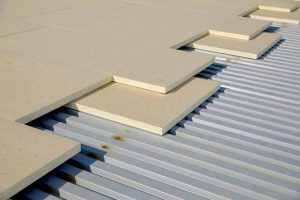
Polyiso continuous insulation (ci) mitigates thermal bridging
Traditional construction practices place insulation between framing members (wood or steel studs), which leaves thermal bridges for heat transfer between indoor and outdoor spaces. Continuous insulation (ci) is an uninterrupted layer over the entire opaque surface of a building’s interior or exterior, which reduces energy transfer due to thermal bridging.
For exterior walls, building teams can specify polyiso ci with a wide variety of structural wall systems and cladding materials such as brick veneer, metal composite material (MCM) panels, and vinyl siding. Sheathing materials such as oriented strand board (OSB) or plywood can also be used. About 12.7 mm (0.5 in.) thick polyiso ci with a R-value of 3.2 can deliver approximately six times the insulation value of OSB or plywood alone, which has an approximate R-value of 0.5 per 12.7 mm (0.5 in.) or 11.11 mm (0.4375 in.) thick sheet. This continuous layer reduces thermal bridging while the increased R-value improves the efficiency of the structure.
Polyiso ci is lightweight compared to other insulation options like mineral wool. Using lighter-weight insulation materials can reduce the need for more robust (i.e. larger size and longer) attachment systems that are required to support heavier insulation options. Typically, additional fasteners or bulky attachment systems will increase the impact of thermal bridging and decrease the efficiency of the insulation. Therefore, by specifying lighter-weight insulation such as polyiso, specifiers can realize the compounding benefits of reduced thermal bridging. In addition, polyiso has a higher R-value per inch compared to mineral wool and, thus, requires a thinner insulation profile in-wall assembly to meet energy-code compliance. This may reduce the size of the attachment system for the cladding and reduce thermal bridging.
Polyiso ci offers superior value and performance as a three-in-one building envelope solution to reduce energy loss, mitigate air leakage, and minimize the risk of moisture intrusion. With properly sealed joints, polyiso ci is available as an approved and code complaint water-resistive barrier (WRB) and can act as an efficient air barrier. In fact, it can remove the need for wall cavity insulation when installed at appropriate thicknesses to meet energy code requirements. By specifying polyiso ci in building systems, specifiers can minimize additional material needs and their associated carbon emissions from manufacturing, transportation, and installation, without compromising building performance.




